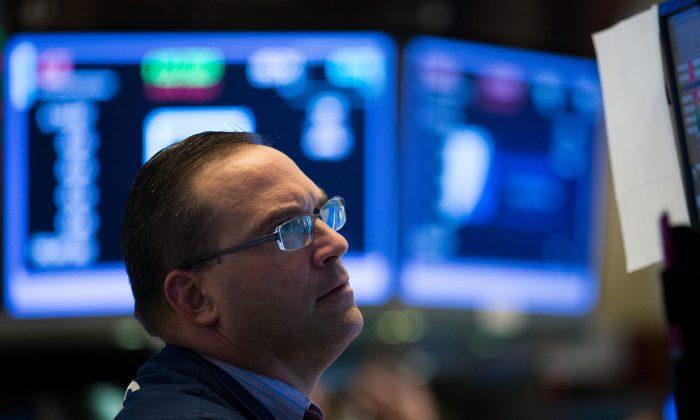Passive investing is a phenomenon increasingly dominating discussion about the stock market.
Depending on one’s allegiances, passive investing can be a blessing or a curse. Given the growing popularity of exchange-traded funds (ETFs), it has become a lightning rod for debates on stock market efficiency, liquidity, and asset bubbles.
Passive investing is a strategy aiming to match the performance of the stock market or an index. In contrast to active investing or management, which is simply traditional “investing,” passive investing does not pick individual stocks in an attempt to beat the market. ETFs tracking the performance of indices have further simplified this process in recent years, by allowing investors to trade them as stocks.
Its popularity is increasingly among retail investors. During the 12-month period ending June 30, investors contributed $302 billion into passively managed U.S. equity funds, compared to a net outflow of $257 billion from actively managed U.S. equity funds during the same period, according to data from Morningstar Research.
However, the strategy has caught the ire of some professional portfolio managers and analysts.
Hedge fund manager Paul Singer, of notable distressed debt fund Elliott Management, railed against the advent of passive investing in his second-quarter letter to investors dated July 27, writing that it “is in danger of devouring capitalism,” according to Bloomberg, which reviewed a copy of the letter.
“What may have been a clever idea in its infancy has grown into a blob which is destructive to the growth-creating and consensus-building prospects of free market capitalism,” Singer said. He argues that funds providing passive products don’t challenge companies to create shareholder value, and funds have little incentive to innovate as they aren’t worried about meeting performance goals.
In other words, price discovery dies.
Lower Fees and Market-Level Returns
To understand passive index funds, consider a traditionally managed equity mutual fund, whose benchmark (or index to beat) is the S&P 500. The active fund manager analyzes industry factors, company-specific information such as earnings and forecasts, macroeconomic trends, and technical charts to come up with a list of stocks to assemble the portfolio. Such activities take time and effort, so active mutual funds typically charge expenses of between 0.5 percent and 2 percent of assets.
A passive index fund doesn’t try to beat the index. The fund buys the same securities, in the same proportions, as the index it wants to match. The returns are similar to the benchmark, and expenses are low because there’s little, if any, research involved.
Recent growth in passive investing is also driven by the fact that most active stock managers cannot seem to beat their respective benchmarks when fees and expenses are factored in. A 2016 S&P Dow Jones Indices study found that the majority of active managers were unable to beat their respective benchmarks over one-year, five-year, and 10-year periods.

(Source: Credit Suisse)
Passive Investing and Market Inefficiencies
The growth of passive investing has fundamentally changed the nature and makeup of the financial markets, some experts argue. And there are risks beyond just nostalgia for the art of stock-picking.
One risk is crowding, “a condition where investors do the same thing at the same time without full consideration of the implications for future asset returns,” according to a Jan. 4 study by Credit Suisse on how passive investing is shaping active management.
“We can separate the concerns about crowding into asset mispricing and a reduction in liquidity. There is growing evidence that passive investing may lead to less efficient prices and an increase in market fragility associated with lower liquidity,” the study said.
What this means is that markets could become less efficient in several ways.
Passive investing favors large and successful companies, as most indices are weighted by market capitalization (value of the company). So the bigger the firm, the more it will be owned by passive index funds. Such trends could result in misallocation of capital, as money will blindly flow into stocks of large companies regardless of underlying health. This risk could create asset bubbles concentrated in large companies.
The herding mentality common among passive investors can also prolong market momentum, as increase in stock price begets further increase in stock price. Large swaths of the market could move in lockstep, decreasing volatility and increasing correlation among stocks. This diminishes the need for fundamental analysis—a stock’s fair value could deviate greatly from its traded price—and the conventional wisdom of “diversifying one’s portfolio” would become ineffective.
The scale of passive ownership also inadvertently encourages monopolistic behavior and lessens competition, according to a July 2016 paper by two professors from the University of Michigan and a management consultant. The authors studied behavior at banks with common ultimate ownership and found that banks which had high common ownership by passive investment managers tended to charge higher fees and pay lower interest rates to customers. The paper suggests “antitrust agencies and Senate allocate considerable resources to understanding the role of institutional investors in product pricing and capacity decisions.”
For example BlackRock, a predominantly passive manager with $5.7 trillion assets under management as of June 30, was found to be “the largest shareholder of more than a fifth of all American publicly traded firms.”
Creation of Asset Bubbles?
A topical issue is the recent growth of “FANG” stocks—those of four technology giants (Facebook, Amazon, Netflix, and Google), which saw their shares appreciate sharply over the last 12 months—and their outsize impact on the recent rise of the S&P 500 Index.
The seemingly unstoppable rise of FANGs has left some analysts scratching their heads. The companies’ market cap far exceeds fair value based on traditional valuation metrics.
Howard Marks, billionaire value investor and co-founder of Oaktree Capital, attributes creation of such asset bubbles to passive investing.
If index funds “buy the FANGs regardless of price, then that’s a risk,” he said on a CNBC segment on Aug. 10. “There’s nobody sitting at the index funds saying, ‘Let’s not buy that today because it’s too expensive.’ They have to buy it.”
“Any time people buy because they have to, the world is a dangerous place,” Marks said.
Because the FANGs are part of so many indices and benchmarks, passive investment funds must own them to properly track the indices. Among Facebook’s five biggest shareholders, three—Vanguard, BlackRock, and State Street—are passive index fund managers, while the other two—Fidelity and T Rowe Price—are mutual fund firms that also have large index funds, according to data from Nasdaq.
Theory Versus Reality
Despite recent handwringing, there isn’t conclusive evidence that passive investing alone has changed the stock market, at least at current levels.
Pravit Chintawongvanich, head derivatives strategist at New York-based Macro Risk Advisors, estimated around 14 percent of the S&P 500 is held passively. But he found little correlation between passive investing and individual stock volatility after studying the behavior of such stocks.
He plotted S&P 500 stocks by passive ownership percentage and price-earnings ratios (P/E), and found no convincing relationship between passive ownership ratios and stock valuations (P/E ratios).
“One would think that the more of the market is held passively, the higher correlation we would see (and thus potentially, higher index volatility),” Chintawongvanich wrote, according to Barron’s. But “that doesn’t seem to be the case,” he said.






Friends Read Free